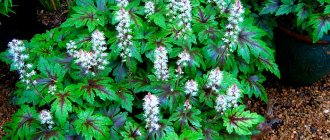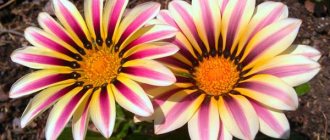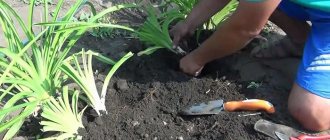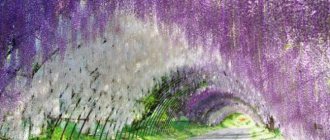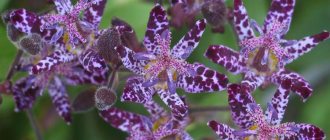The historical habitat of the species is the plains of Central and South America. Despite the foreign origin of heliopsis, it can hardly be called exotic in our gardens. Quite the opposite, it’s hard to imagine grandma’s front garden or summer cottage without the towering “golden balls” of this plant. The name Helios opsis is literally translated from Greek as similar to the sun, and it is not for nothing that the always bright golden-yellow balls of inflorescences can rise above the site to a height of up to 160 cm.
Description of heliopsis
The Heliopsis genus includes about 10-15 species of perennial and annual plants and belongs to the Asteraceae or Asteraceae family.
Varieties of different heights allow you to find a place in almost every flower bed. Stems are erect, highly branched. A variety such as rough heliopsis can grow up to 160 cm in height. The popular Variegated heliopsis grows in height up to 90 cm. It gained its popularity due to the unusual white color of the foliage. Other varieties have green, opposite or alternate leaves. The leaf shape is oblong, with jagged edges. The root system is fibrous, powerful, and grows quickly.
The flowers are colored in yellow and orange shades. There are terry and simple baskets collected in paniculate inflorescences. You can admire the flowering from July to November. Faded flowers must be cut off; this will preserve the decorative appearance of the bush and speed up the appearance of new inflorescences. The heliopsis flower is gaining popularity as a plant for Provençal-themed bouquets. After flowering, a flat and bare achene is formed, charcoal, almost black, in color, up to 0.3 cm in length.
Heliopsis varieties
The only decorative type of heliopsis compensates for the large number of varieties bred on its basis. Selection is carried out all over the world, but the most famous varieties of sunflower are obtained in the UK, where heliopsis is a very popular garden perennial. Many of the varieties have received the prestigious Royal Horticultural Society Award.
Varieties differ in the color and shape of the inflorescences, the shade of the leaves and the height of individual bushes. The most popular of them are:
- “Light of Loddon” is a low (up to 1 m) perennial with large spear-shaped leaves and small (up to 8 cm) golden-yellow flowers that bloom in mid-summer.
- "Benzinggold" (Benzinggold) is a large ornamental plant, distinguished by semi-double inflorescences with an orange center and yellow edges.
- "Waterperry Gold" (Waterperry Gold) - reaches 1.2 m in height, has a very long flowering (throughout the summer). The inflorescences are semi-double, deep yellow.
- “Sonnenglut” (Flame of the Sun) is a medium-tall (up to 1.2 m) variety with dark green glossy leaves and yellow-orange flowers.
- "Loraine Sunshine" (Lorraine Sunshine) or "Winter Sun" (Winter Sun) is a very beautiful compact (up to 0.9 m) perennial, the main highlight of which is its variegated leaves. The leaf blade is painted silver-gray; dark green veins stand out brightly against a light background. Yellow daisy-shaped inflorescences appear in June and bloom until early autumn.
G. "Light of Loddon", G. "Benzinggold", G. "Sonnenglut", G. "Loraine Sunshine"
- "Spitzentänzerin" or "Ballerina" (Ballerina) is a herbaceous plant about 1.2 m high, decorated with large dark green leaves and golden inflorescences.
- “Prairie Sunset” (Sunset on the prairie) - golden-yellow flowers with an orange center, the shoots are dark green with a hint of purple. The height of an individual bush can reach 1.6 m, flowering time is from June to early September.
- “Summer Sun” (Summer Sun) is a drought-resistant variety with small double bright yellow flowers, the size of which is from 5 to 7 cm. The total height of the plant is about 1 m. Thanks to the straight, stable stems, the variety is excellent for cutting.
- "Sunburst" (Solar Burst) is another variegated variety: dark green veins stand out against the creamy background of the leaf. The inflorescences are simple, golden yellow. The height of the bush is about 0.9 m.
G. "Spitzentänzerin", G. "Prairie Sunset", G. "Summer Sun", G. "Sunburst"
- “Venus” (Venus, Venus) is a fairly tall (up to 1.2 m) variety with strong stems bearing large (12 cm) golden-yellow inflorescences.
- "Asahi" (Asahi) is a very decorative variety with numerous yellow-orange double inflorescences. The average height of an individual plant is 0.8 m.
- "Summer Nights" - bright yellow inflorescence with an orange center.
- “Sommerzwerg” (Summer Dwarf) is a dwarf (no more than 0.6 m) variety with a large number of golden-yellow flowers and dense dark green foliage.
G. "Venus", G. "Asahi", G. "Summer Nights", G. "Sommerzwerg"
Heliopsis in landscape design
Sunflower is a luxurious plant with bright flowers framed by dense greenery, which looks great both in single plantings and in flower beds. Heliopsis can be planted as a tapeworm in a sunny lawn or lawn. A large bush will become an excellent dominant among the open space, and yellow flowers will dilute the monotony of greenery.
As for group plantings, a wide variety of options are possible here. Flower beds made up of various representatives of the aster family look good: heliopsis, echinacea, calimeris, gaillardia, pyrethrum. Particularly interesting is the combination of yellow heliopsis inflorescences with pink and purple flowers of echinacea and pyrethrum. The undoubted advantage of such a flower bed is easy care, since all of the above plants require approximately the same conditions.
It is not forbidden to plant different species compositions, but in this case you should pay attention to the flowering time of each species and the height of the plants. Since heliopsis is quite tall, it should be placed in the background so that it does not interfere with smaller flowers. Lilies, phlox, speedwell, bluebells, and large cornflowers are good flower partners for sunflowers.
Heliopsis can also be planted near a house or outbuildings. Due to its fairly large size, the plant is able to hide unsightly facades, but at the same time it will not block windows or prevent the penetration of sunlight. Placed along a fence, the perennial can be a kind of hedge that blooms beautifully in summer.
Many varieties of heliopsis are perfect for cutting - large flowers on tall stems last a long time in a vase and do not lose their freshness.
Types and varieties
Heliopsis flowers have spread in gardens thanks to selection, which has given inflorescences of various shapes, creating varieties that are resistant to the cold of central Russia and pests. The ancestor of most hybrids is Heliopsis Sunflower.
Heliopsis Burning Hearts
Heliopsis Rough
Heliopsis Rough was bred from Heliopsis Sunflower. It got its name from the hard fibers that cover the stem and leaves of the plant. This species grows up to one and a half meters in height. The leaves are arranged oppositely on short petioles. The inflorescence is yellow in color and reaches a diameter of up to 7 cm.
Heliopsis Rough
Heliopsis Lorraine sunshine
Heliopsis Lorraine Sunshine is an unpretentious variety with a light aroma. A simple inflorescence, a basket, is framed by rounded yellow petals. Peduncles rise to a height of 70-80 cm. A special feature of this variety is the beautiful white color of the leaf plate with green veins.
Heliopsis Lorraine sunshine
Heliopsis Summer Knights
A large variety, reaching a height of 1.2 m. Bred by American breeders. Characterized by dark, almost brown, stems and leaves with a bronze tint. In the center of the inflorescence there is an orange-red core. The flower is simple.
Heliopsis Summer Knights
Heliopsis sunflower
Heliopsis Sunflower is a perennial plant with straight branched stems reaching a height of 100 cm. The leaf blade is solid, oval in shape, with jagged edges, the leaves are arranged oppositely. The inflorescence is golden-yellow, reaching 8-9 cm in diameter, double or semi-double. Blooms profusely all summer.
Heliopsis sunflower
Heliposis varieties
Title Description Photo Lorraine Sunshine
In addition to beautiful sunny flowers, it has another distinctive feature - beautiful variegated leaves.
Summer san
A bush with the largest flowers that closely resemble sunflowers. This is the largest “sun” in size among other Asahi subspecies
The middle is almost invisible, the shape of the flower is more reminiscent of a mini-dahlia than a daisy. Despite not being very tall, it is an elegant and incredibly lush variety. Due to its relatively low location to the ground, it does not require additional supports Summer Pink
Like Lorraine, it stands out more for its leaves than for its inflorescences; each leaf has a purple color, shades closer to purple, while all the veins are of a surprisingly emerald color. Such rich shades in contrast emphasize the brightness of the yellow petals. The shape is also bizarre - the edges are slightly curved inward
Goldenfielder Each cup is filled with several tiers of petals of different lengths
Bright handsome heliopsis
Plant care
Heliopsis flowers are completely unpretentious inhabitants of the garden. To obtain a lush and abundant bush, the plant is periodically pinched. Strongly branched long shoots need support. The plant is fed rarely, once every 3-4 weeks is enough.
Location and lighting
For planting, it is better to initially choose a well-lit place in the garden. In dark areas of the garden, the stems become very elongated and bloom worse. “Golden balls” do not like stagnant moisture, so you need to take care of drainage in advance. The acidity of the soil should be neutral. The flower grows quickly, so when choosing a place, you should take into account the need for regular weeding of the growth.
It is not recommended to plant the plant in a place where Jerusalem artichoke or sunflower previously grew. The pests and diseases of these species are similar.
Watering and soil care
Even a novice gardener can cope with planting and caring for heliopsis. The flower is drought-resistant and does not require additional watering, except at the time of planting. Only in dry summers, for the formation of good inflorescences, it is necessary to water regularly.
You can ensure oxygen access to the roots by loosening the top layers of soil. The soil must be fertile and contain humus, but the plant will also take root in loamy soils.
Top dressing
Fertilizing is carried out once a month with organic or mineral fertilizers. You should not overfeed the plant; this will lead to vigorous growth of the plant’s green mass.
Rules of Loving Care
Gardeners have noticed that neglect of plants often leads to loss of decorative properties and sometimes death. Heliopsis hybrid varieties require special attention. During dry periods, flowers are additionally moistened using a watering can or spray bottle. A few days after the procedure, the dried soil is slightly fluffed up so that the root system receives a dose of oxygen.
If flowers grow in rich soil, refrain from fertilizing. Otherwise, heliopsis will produce many shoots without buds. To form a beautiful bush, the plant is cut and the tops are pinched. Thanks to this, it puts out lateral branches and gradually becomes rounder. Supports are installed near young specimens. They help the crop withstand strong winds and heavy rainfall.
If the flowers are infected by aphids, they are treated with a solution of laundry soap or an insecticide.
The technology for planting and caring for heliopsis in an open flower bed is quite simple for novice gardeners. The first step is to choose a crop variety. Then the method of sowing: in open ground or for seedlings. Prepare the soil for the container and in the flowerbed. Follow the diagram provided by agronomists. As a result, a sunny flower called heliopsis will shine with its fire at the dacha.
Diseases and pests
The plant is resistant to diseases and pests. In rare cases, it can be affected by powdery mildew. The disease manifests itself as a white coating on the leaves. Treatment with copper sulfate and Fundazol helps combat it. It is recommended to water the soil before wintering. During the growing season, spray the plant with a 0.5% solution of colloidal sulfur.
In dry and arid years, this sunny flower is attacked by aphids. To combat insects, the following drugs are used: Fufanon, Fitoverm, Iskra.
Description and general information about the plant
Heliopsis belongs to herbaceous varieties of plants from the Asteraceae family and can be either annual or perennial, depending on the variety.
Its stems reach 150 cm in height, and the leaves are arranged alternately or oppositely, and have an oblong shape with denticles along the edges. Planted in a flowerbed, heliopsis grows quickly, but its long stems sometimes need gartering, although even under strong gusts of wind they do not break, but simply bend to the ground.
[adsp-pro-4]
The plant blooms with golden-yellow inflorescences reaching 8-10 cm in diameter. Depending on the variety, these “baskets” can be semi-double, terry or smooth.
In areas with a temperate climate, the flowering period occurs in the last days of June and lasts 70-75 days. And if the autumn is warm, the flowers will remain until the end of October, until the first frost destroys them.
Planting and propagation of plants
Heliopsis is a plant that quickly spreads throughout the garden. Shoots and seeds can independently conquer new territories. In the garden, you can set aside a far corner in the depths of the flowerbed for the plant, since planting and caring for heliopsis is minimal.
Growing
Growing new plants is not a difficult process. Despite the fact that the plant can grow in one place for decades, it is recommended to replant it every 4-6 years. If this is not done, the bush will become very thick and the flowers will be smaller. The distance between young bushes should be at least 40-60 cm.
Reproduction
There are two ways to grow a young plant. By dividing rhizomes and seeds.
Dividing the bush
Heliopsis is a herbaceous plant for open ground in temperate latitudes and tolerates wintering well. Propagation by dividing the rhizome can be done both in autumn and spring. To do this, an overgrown adult (4-5 years old) plant is dug up. The rhizome, cleared of soil, is divided into parts with a sharp, clean knife so that each root has a bud, then planted in a new place. The new planting site is first loosened and fertilized. If the soil is clayey, provide good drainage, water it abundantly, especially in the first weeks after planting, preventing the soil from drying out. Heliopsis planted in this way begins to bloom this year.
Growing from seeds
Fresh seeds produce good quick shoots. They can be planted before winter (October-November) or in spring (March-April). For seedlings, seeds are sown already in February, and the plant can be transplanted into open ground in May. Seeds that are stored for more than a year must undergo stratification. Place them in damp material or soil (a napkin or sand will also work), cover with plastic and place in the refrigerator for 30 days.
You can plant seeds in any nutritious soil, including for indoor flowers. Heliopsis seeds can be immediately planted in separate containers, one seed at a time. When planting seeds in a common box, there must be a distance of at least 5 cm between the seeds, and a planting depth of no more than 1 cm. There must be holes and drainage at the bottom of the containers. You can speed up the germination process by covering the seeds with film. Shoots will appear within 2-3 weeks. Choose a window with good lighting for seedlings.
A month before transplanting the plant into open ground, begin hardening. When exposing seedlings to the open air, remove the film first for an hour, then increase the time.
Preparing for winter
After the end of the growing season, the upper part is cut off at the base and left to overwinter in open ground. The plant easily tolerates frosts in central Russia. Dry shelter is required if the winter is warm and humid. To do this, you can use sawdust, spruce branches and other specialized covering material.
Growing heliopsis from seeds
Sowing seeds for seedlings
Gardeners grow heliopsis both through seedlings and sow its seeds directly into open soil. Sowing seeds in open ground is carried out in the middle of spring or late autumn, while seedlings are sown in the last winter weeks.
If you decide to grow such a flower through seedlings, then prepare a soil mixture that should include coarse sand, turf soil and peat (1:1:1). Half a month before sowing the seeds, it should be spilled with a strong solution of potassium permanganate, after which the container is covered with glass or film on top. Immediately before sowing, the soil mixture is poured into a box, at the bottom of which there are holes for drainage; also do not forget to make a good drainage layer of expanded clay. Level the surface of the substrate and evenly distribute the seeds over it, then cover the container on top with glass or film and transfer it to a well-lit and warm place (about 20 degrees), where it will stay for 7 days. Please note that crops need bright but diffused sunlight. After this, the crops are transferred to a colder place (from 3 to 4 degrees), where they will stay for 30 days, during which time the seeds will undergo cold stratification. When the allotted time is up, the container is transferred to a warm place (from 25 to 28 degrees). Do not forget to systematically remove the shelter for ventilation, and you must also remove accumulated condensation from its surface.
The cover from the container is removed only after the emerging seedlings begin to form real leaf plates. Picking of plants is carried out during the formation of their first pair of true leaf blades. To do this, use peat cups, which need to be filled with substrate (its composition is described above). Picked flowers should be moved to a fairly cool place (from 13 to 15 degrees). Caring for such seedlings is very simple; to do this, you need to water them in a timely manner, as well as systematically and carefully loosen the surface of the soil mixture.
Heliopsis in landscape design
These simple flowers are perfect for a garden in a rustic or Provençal style. They will complement a flower bed with phlox, delphinium and calendula, and create a voluminous sun spot on a green background. You can choose tall varieties for decorating a fence or short ones for flowerpots and the front edge of a flower bed. Varieties with decorative leaf coloring will begin to delight with their grace even before flowering. Having a pleasant smell, heliopsis will attract butterflies and bees to your garden.
Heliopsis: cultivation and care in open ground
Heliopsis is not capricious, despite its sunny name, it is not pampered and stoically tolerates both heat and frost. It will also survive drought just as heroically if for some reason you are unable to water the flower. You will learn about his personal tragedy only from later and smaller flowering, but this will be a silent reproach that only a sensitive owner can notice. He won’t say a word if he gets “exiled” to the shadows: his shoots and flowers will only become a little thinner and smaller.
Heliopsis - a little sun in your garden
Fact! The only thing that the “sunny ball” does not tolerate is limestone and loam. He is quite comfortable in ordinary garden soil. If the soil is prone to the accumulation of excess water, you should arrange drainage for the heliopsis before planting, and this flower will be immensely grateful to you.
How to grow, care, pests and diseases
When planting heliopsis (in the form of seeds or seedlings), the following rules must be followed:
- Planting is carried out in dry and well-lit places.
- It is necessary, as already mentioned, to plant flowers in fertile (in moderation) and well-drained soil.
- When planting seedlings, you must maintain a certain distance between bushes - at least 35 cm, and the distance between rows - at least 50 cm.
- The best time to plant heliopsis is spring.
The great advantage of this plant is that it is extremely unpretentious, and therefore very easy to care for. Here, too, you should follow a few simple rules:
- You should not water the plant too often, as excessive amounts of moisture can harm it;
- tall varieties need a garter to supports, since strong winds can break their long stems;
- during the flowering period, it is necessary to regularly remove faded inflorescences, and in late autumn - cut the stems to ground level;
- it is necessary to remember to loosen and regularly weed the soil around the plants;
- It is advisable to feed the plantings with mineral or organic fertilizers approximately once every 20 days.
As for protection from pests, you should know that the beautiful flowers of heliopsis and their bright leaves may appeal to aphids, and systemic insecticides will help get rid of them.
In fact, this plant is not very susceptible to diseases, but sometimes you can see dark spots on its leaves, which may indicate rust, or a light gray coating, which may indicate powdery mildew. In this case, the affected shoots must be cut off, and healthy shoots must be treated with a solution of Fundazol copper or vitriol (this can also be done for preventive purposes in the spring).
Description of the species of perennial varieties of Heliopsis helianthoides
Large-leaved hydrangea blooming on the current year's shoots
There are about 15 species of heliopsis. Some of them are perennial, while others, on the contrary, grow only for one year. Varieties differ in appearance and have certain characteristics.
Sunflower
This type includes classic plants. Heliopsis sunflower reaches 1 meter, the leaves have serrated edges, there are few of them. The inflorescences are large, bright yellow. The core resembles a chamomile, but is larger in size.
Variegated
Plants of this species are distinguished by the variegated color of their leaves. Due to the presence of mutant cells that are unable to produce chlorophyll, light spots and veins gradually appear on the leaves of Heliopsis variegata.
Variegated heliopsis
Rough
Also classified as sunflower. The length of rough heliopsis reaches one and a half meters. The plant is distinguished by large buds and large flowers, the leaves are large and rough to the touch.
Terry
Terry varieties are distinguished by inflorescences with a large number of petals, which makes the flower voluminous and gives it an attractive appearance. These types of terry heliopsis look very elegant.
Other
Quite a few varieties of the plant have been developed. They differ in height, shade of petals, and splendor of inflorescences. Some varieties have few petals, and they are arranged in a couple of rows - these are smooth or simple “baskets”. Those with a little more of them are classified as semi-double varieties.
Possible problems in growing
The perennial can also experience problems and diseases, although this is rare for this plant.
The most common difficulties:
- Problems with leaves in variegates. They arise as a result of excessive watering or damage to certain diseases.
- Pests. Heliopsis Sunflower does not attract the attention of many pests. In hot weather, it can be affected by aphids, which are treated with standard insecticides - Fitoverm, Aktara.
- Diseases. The plant can be affected by powdery mildew and other fungal diseases. Take the usual measures to combat such diseases.
- Signs of improper care. If the rules are not followed, the plant may “hang” its leaves, bloom poorly, and the inflorescences appear small.
Heliopsis variegated is a beautiful and unpretentious plant that even a novice gardener can grow. The choice of varieties is huge, so everyone will choose a flower to their liking.
